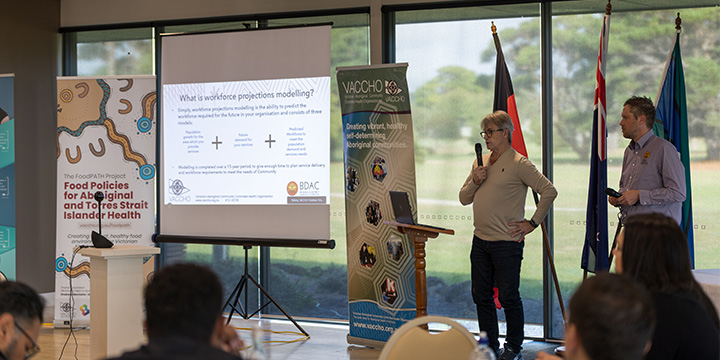The Victorian Government’s commitment to First Nations self-determination has placed greater responsibility on the Aboriginal Community Controlled Organisation (ACCO) sector to be the leading provider of holistic, wrap-around care to First Nations communities across Victoria.
Critical to the ability of ACCOs to provide care to communities is a strong and able workforce. In 2022, the Victorian Aboriginal Community Controlled Organisation (VACCHO) released their 5-year Victorian Aboriginal Health and Wellbeing Workforce Strategy. The strategy aims to support a strong and able workforce across the ACCO sector to deliver holistic health and wellbeing services to First Nations people.
VACCHO is the peak representative body for First Nations health and wellbeing in Victoria, with a vision for vibrant, health, self-determining Aboriginal communities. They provide a united voice for their Members – 33 ACCOs from across Victoria – to ensure they have a say on decisions made about their community. VACCHO also provide various services to their Members to support the delivery of high-quality, culturally safe health and social services to the First Nations community across the state. This includes:
- providing training to ACCO sector staff through their Registered Training Organisation
- providing cultural safety training and audits to other organisations
- supporting ACCO workforce skills development
- influencing and advising on government policy development.
Project impact
The project built an evidence base on First Nations population and workforce demand over the next 15 years that did not exist previously, with our projections forecasting Victoria’s First Nations population to increase by 74% by 2037, and overall ACCO workforce demand to double.
The analysis was highly valued by senior management across VACCHO and their Members, to support both long-term planning and advocacy to government. The project has already been shared widely by VACCHO and generated interest across the sector.
VACCHO is now rolling out the model to support Members with requirements for infrastructure grants, operational and logistical needs, and for workforce planning and development.
The objective
To support VACCHO and its Members to understand workforce demand over the next 15 years, to support future workforce planning and advocacy to government.
The role we played
With support from demographer Taylor Fry and in partnership with VACCHO, we developed three interdependent models that project, for an individual ACCO and their catchment area:
- Aboriginal and Torres Strait Islander population
- service demand
- workforce needs.
The model projected workforce needs for the 12 different service areas that their Members operate across.
Together, we used these three interdependent models to develop workforce demand projections for four of VACCHO’s 33 ACCO Members: Bendigo and District Aboriginal Co-operative, Dhauwurd-Wurrung Elderly and Community Health Service, Ramahyuck District Aboriginal Corporation, and Rumbalara Aboriginal Co-operative.
Inputs to develop the model and projections were gathered from multiple sources, including:
- external publicly available data sources
- consultations with key stakeholders
- detailed data provided by each individual ACCO on their catchment area, clients and staff.
The VACCHO model built on work we had previously undertaken with the Victorian Aboriginal Child Care Agency (VACCA) and the Aboriginal Executive Council (AEC) to project population and workforce demand across the seven sectors they worked in.
Critical to the success of the project was the deep, trusting working relationships developed between SVA, VACCHO and our Members. Without this trust, and the time invested by staff at VACCHO and our Members, critical data needed to develop projections would not have been available.”Jim O’Shea • Proud Gumbaynggirr Man, Chief Operating Officer and Company Secretary, VACCHO
Meet the team
-
 Principal, Consulting (NSW) Alex Batchen
Principal, Consulting (NSW) Alex Batchen




